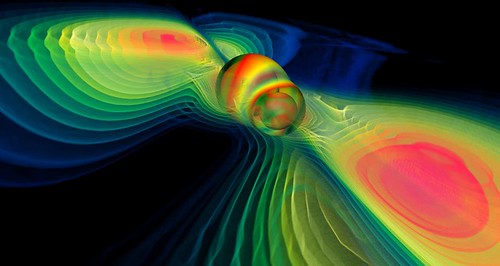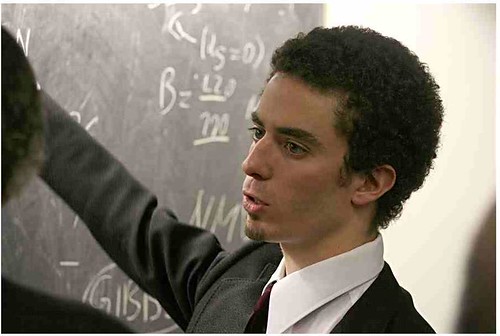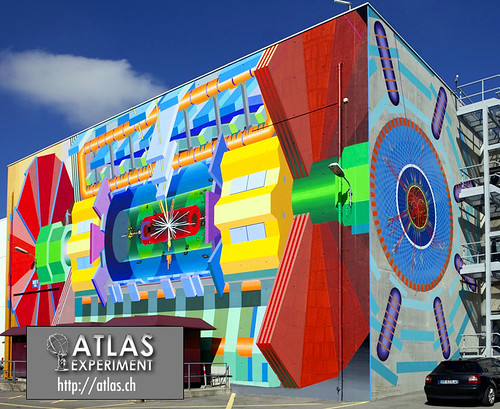Who cares about gravity?
- By Umberto Cannella
- August 22, 2012
- 1 Comment

Numerical simulation of two merging black holes performed by the Albert Einstein Institute in Germany: what this rendition shows through colors is the degree of perturbation of the spacetime fabric, the so-called gravitational waves. Credit: Werner Benger
Who cares about gravity? Shouldn’t this be a settled question by now? This is actually one of the reasons why I wanted to become a theoretical physicist: I longed for knowing more about this apparently obvious but deeply mysterious force of Nature. I’ve always shared the mindset of the great Einstein: “I want to know God’s thoughts, the rest are details.”
Here I am then, mingling with some of the smartest minds in the world, theoretical physicists at NASA and the University of Maryland to study gravitational waves, a new type of astronomy. I got here a year ago, soon after earning my doctorate at the University of Geneva. That’s right, Geneva: the place where the end of the world might be provoked by that crazy underground machine, the one that is after the Higgs boson and could produce mini black holes (don’t worry: this is a remote and harmless possibility). I am very happy I could visit the facility and its particle accelerator, which is called the Large Hadron Collider, or LHC, and is the flagship of CERN, the European Center for Nuclear Research. Even though this very sophisticated, huge and unique apparatus has been built to know something new about the invisible world of subatomic particles, there is hope that the discoveries made will shed some light on the mysteries of gravity, too.

A younger Umberto dressed up on occasion of his master thesis defense at the University “La Sapienza” of Rome. After obtaining his master in physics, Umberto moved to Geneva for his doctorate. Credit: Umberto Cannella
As a matter of fact, gravity is still a kind of a mystery: it is way more complicated and profound than the concept of a force which Newton grasped when an apple fell on his head, helping him realize how the very same force makes the Earth and the other planets orbit around the Sun. Deep down, gravity is not even a force. As Einstein discovered, it is the consequence of the curvature of space-time (isn’t it obvious?): not only space and time are not separate realities but the entity resulting from their merge is as real and deformable as a couch pillow: you just need very heavy objects, like the Sun, to make this characteristic apparent.
I am sure that all this sounds very peculiar and very curious if you had not already heard of these phenomena before … but is it all this more than just an intriguing curiosity? My claim is yes, it is much more than that! Try to remember when you were a kid: the moment you found out about something new, you immediately wanted to make some use of it and, most likely, this use was playing. However, you could not have played with the new toy, had you not been aware of its existence in the first place. Same thing happens with physics and other sciences as well: when you acquire a new piece of knowledge, a new horizon opens up too; beyond this horizon lies what was unimaginable before. The more you explore the new world, the more awesome playing becomes: you can think of bringing the new toy in the realm of the old toys and create new adventures with them. In doing this you are behaving exactly like a scientist: you are making connections among ideas and waiting to see what comes out of this exploration.
The new picture Einstein drew about gravity enabled us to play with space-time at our advantage. As an example take GPS, the Global Positioning System: it is composed of a network of satellites orbiting the Earth to help us determine our position when we walk, drive or fly around our planet. In order to do this it is necessary that GPS satellites know of Einstein’s theory of gravity! In fact at the speed and height of the satellites clocks tick differently than their twins on Earth, slightly but sizably: if scientists didn’t account for these differences the GPS system would become useless in less than a day!

A mural outside CERN, where the most advanced accelerator ever built is currently revolutionizing our understanding of the universe. Artist Josef Kristofoletti drew a full scale representation of the ATLAS experiment, one of the two which have recently discovered a new particle that closely resembles the Higgs boson.
Credit: CERN
Similarly, investigating what is smaller than an atom has taught us something more about how the particles making our own body behave. It is not by chance that LHC is now smashing against each other bunches of particles called hadrons and we have hadron-therapy to cure certain type of tumors. Still at CERN, before LHC was up and running, to fulfill some communication need of theirs, scientists invented the World Wide Web, thanks to which you are now reading this piece.
The list of incidental benefits of scientific research could go on for very long: NASA itself has a website dedicated to its own spinoffs, as they are referred to in jargon.
By coming to grips with a wealth of brand new information we inevitably bump into the basis of future inventions and, behold, this is no Nostradamus prophecy but a prediction backed up by our past and present. Beware though: there is no replacement for such a process, you have to keep on playing!
This is basically what I came here to do: playing with ideas that entail space-time can wobble like a drum; today, confirming these ideas might satisfy the curiosity of a bunch of experts but tomorrow they will make the whole mankind richer in terms of knowledge and possibilities. So, if you ask, “Who cares about gravity?” I’d answer promptly: “I do! … what about you?”



gravity IS kind of a mystery, i like reading and learning more about it, just like about the big bang theory. very interesting post, Sara!